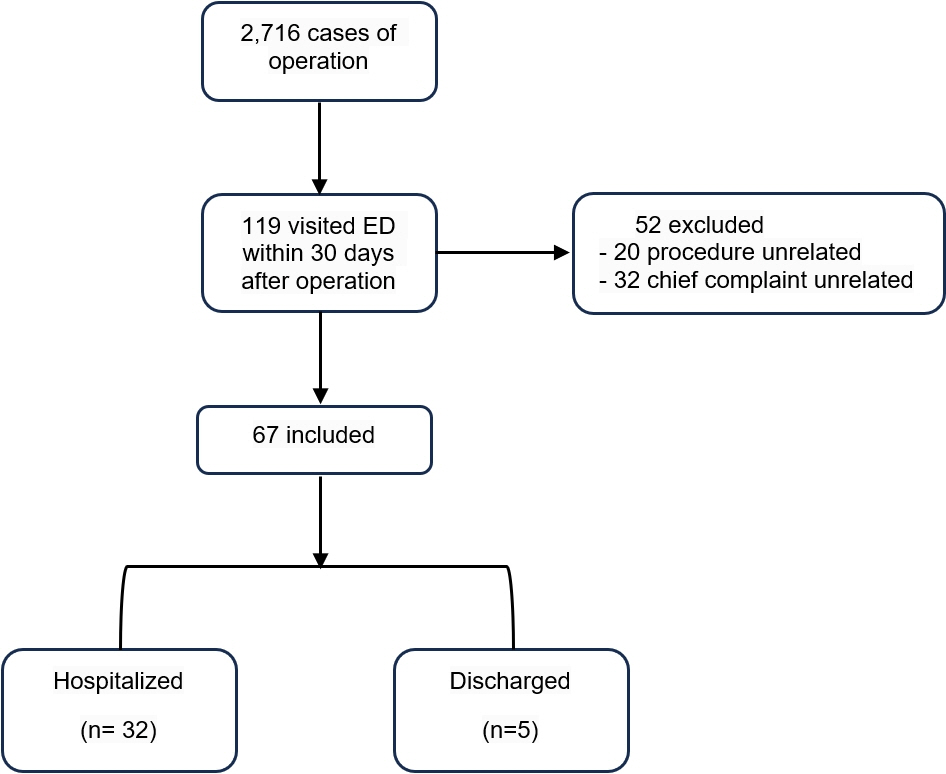Pediatr Emerg Med J.
2024 Jan;11(1):11-16. 10.22470/pemj.2023.00864.
A study on the characteristics of patients visiting the pediatric emergency department with post-tonsillectomy hemorrhage
- Affiliations
-
- 1Department of Emergency Medicine, Seoul National University Hospital, Seoul, Republic of Korea
- KMID: 2549536
- DOI: http://doi.org/10.22470/pemj.2023.00864
Abstract
- Purpose
This study was performed to identify risk factors associated with post-tonsillectomy hemorrhage (PTH)-related hospitalization in pediatric patients visiting an emergency department (ED).
Methods
We retrospectively reviewed the medical records of patients who underwent tonsillectomy at a single children’s hospital ED from January 2009 through December 2020. Data were collected on patient demographics, chief complaints, surgical methods, postoperative days, initial vital signs, and laboratory findings. The study population was divided into hospitalized and discharged groups.
Results
Among a total of 2,716 patients reviewed, 67 met the inclusion criteria. The hospitalized group showed a lower median systolic blood pressure (108.0 [interquartile range, 82.0-134.0] vs. 118.5 [89.8-147.2] mmHg; P = 0.021) and a faster median respiratory rate (23.0 [18.0-28.0] vs. 20.0 [17.0-23.0] breaths/minute; P = 0.019), compared with the discharged group. Multivariable logistic regression identified systolic blood pressure under 100 mmHg (odds ratio, 5.21; 95% confidence interval, 1.17-37.60) and respiratory rate over 24 breaths/minute (7.31; 1.07-145.79) as the factors associated with PTH-related hospitalization.
Conclusion
When pediatric patients visit EDs for PTH, close monitoring or hospitalization may be needed in those with low systolic blood pressure or rapid respiratory rate.
Keyword
Figure
Reference
-
References
1. Mitchell RB, Archer SM, Ishman SL, Rosenfeld RM, Coles S, Finestone SA, et al. Clinical practice guideline: tonsillectomy in children (update). Otolaryngol Head Neck Surg. 2019; 160(1 Suppl):S1–42.2. Wall JJ, Tay KY. Postoperative tonsillectomy hemorrhage. Emerg Med Clin North Am. 2018; 36:415–26.3. De Luca Canto G, Pacheco-Pereira C, Aydinoz S, Bhattacharjee R, Tan HL, Kheirandish-Gozal L, et al. Adenotonsillectomy complications: a meta-analysis. Pediatrics. 2015; 136:702–18.4. Liu JH, Anderson KE, Willging JP, Myer CM 3rd, Shott SR, Bratcher GO, et al. Posttonsillectomy hemorrhage: what is it and what should be recorded? Arch Otolaryngol Head Neck Surg. 2001; 127:1271–5.5. Lindquist NR, Feng Z, Patro A, Mukerji SS. Age-related causes of emergency department visits after pediatric adenotonsillectomy at a tertiary pediatric referral center. Int J Pediatr Otorhinolaryngol. 2019; 127:109668.6. Burckardt E, Rebholz W, Allen S, Cash E, Goldman J. Predictors for hemorrhage following pediatric adenotonsillectomy. Int J Pediatr Otorhinolaryngol. 2019; 117:143–7.7. Aldrees T, Alzuwayed A, Majed A, Alzamil A, Almutairi M, Aloqaili Y. Evaluation of secondary post-tonsillectomy bleeding among children in Saudi Arabia: risk factor analysis. Ear Nose Throat J. 2022; 101:135–42.8. Goncalves AI, Rato C, de Vilhena D, Duarte D, Lopes G, Trigueiros N. Evaluation of post-tonsillectomy hemorrhage and assessment of risk factors. Eur Arch Otorhinolaryngol. 2020; 277:3095–102.9. Spektor Z, Saint-Victor S, Kay DJ, Mandell DL. Risk factors for pediatric post-tonsillectomy hemorrhage. Int J Pediatr Otorhinolaryngol. 2016; 84:151–5.10. Susaman N, Kaygusuz I, Karlidag T, Keles E, Yalcin S, Cilibas RE. Risk factors for post-tonsillectomy hemorrhage. ENT Updates. 2018; 8:114–9.11. Harounian JA, Schaefer E, Schubart J, Carr MM. Pediatric adenotonsillectomy and postoperative hemorrhage: demographic and geographic variation in the US. Int J Pediatr Otorhinolaryngol. 2016; 87:50–4.12. Lane JC, Dworkin-Valenti J, Chiodo L, Haupert M. Postoperative tonsillectomy bleeding complications in children: a comparison of three surgical techniques. Int J Pediatr Otorhinolaryngol. 2016; 88:184–8.13. Steketee KG, Reisdorff EJ. Emergency care for posttonsillectomy and postadenoidectomy hemorrhage. Am J Emerg Med. 1995; 13:518–23.14. Peterson J, Losek JD. Post-tonsillectomy hemorrhage and pediatric emergency care. Clin Pediatr (Phila). 2004; 43:445–8.
- Full Text Links
- Actions
-
Cited
- CITED
-
- Close
- Share
- Similar articles
-
- Erratum for: A study on the characteristics of patients visiting the pediatric emergency department with post-tonsillectomy hemorrhage
- Spontaneous Tonsillar Hemorrhage and Post-Tonsillectomy Hemorrhage
- A Case of Upper Gastrointestinal Hemorrhage Misdiagnosed as Post-Tonsillectomy Hemorrhage
- Clinical Analysis of Post-Operative Hemorrhage after Tonsillectomy
- Complications of Tonsillectomy


